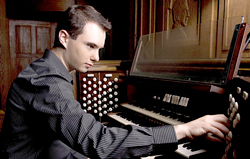by Timothy Robson

Louis Vierne, born nearly blind in 1870, studied organ at the Paris Conservatory, then served as assistant to his teacher Charles-Marie Widor at Saint-Sulpice. He became the organist at Notre Dame Cathedral in 1900, a post he held until his death in 1937. During the course of his career he composed six symphonies for solo organ, multi-movement works designed to show off the capabilities of the new organs being installed in many French churches by builder Aristide Cavaille-Coll, whose technological innovations enabled richness of sounds and mechanical combinations not possible in older organs. Vierne’s third symphony dates from 1911, at a period in Vierne’s life when he had recently been passed over to be professor of organ at the Paris Conservatory. The first movement of the third symphony in particular has a sense of anger in its dissonance and highly chromatic harmonies. The other movements include a “Cantilène” of great melodic interest; a scherzo-like “Intermezzo”; a large “Adagio” movement; and a brilliant toccata-like “Final.”
Christopher Houlihan achieved considerable notoriety in the organ world in 2012 for his performances of all six of Vierne’s symphonies in two concerts each in six different cities, marking the composer’s centennial. His performance here showed an abundance of virtuosity and technical achievement, yet for this listener his performance never quite caught fire. Despite the technical perfection of his playing, there seemed to be a lack of communication of the musical essence of the symphony. There were moments, especially in the beautiful Adagio when it all came together, especially in Houlihan’s flexibility of rhythm and his emphasis on the tension resident in the chromatic harmonies and the resolution of dissonances.
After intermission, the story changed. Houlihan’s performance of Liszt’s thirty-minute operatic fantasy on a chorus from the first act of Giacomo Meyerbeer’s 1849 opera Le Prophète was captivating. This fantasy is the organ equivalent of Liszt’s Sonata in B minor for piano in its scope. Houlihan played the piece, which falls into three large sections, from memory, and his playing was riveting.
Liszt composed his fantasy and fugue in 1850, part of a string of paraphrases of opera melodies meant to show off the composer’s facility of improvisation and, in a sense, to advertise the Meyerbeer opera composed the previous year. With its great length and musical development, the Liszt Ad nos can only be performed as a concert work; because of its extraordinary technical demands it is rarely performed.
Liszt first introduces and develops snippets of the Meyerbeer chorale, building time and again to climaxes. These virtuosic passages must have the sense of fantasy and improvisation. The second major section, the equivalent of a central slow movement, is an extended set of variations on the choral melody, which is first introduced in a single melody line on a soft flute stop. There is a transition to the fugue, which is only reliant on true fugal technique for a few pages, before Liszt reverts to a “fantastic” development of the chorale melody, ending in a blaze of C Major trumpet fanfares and full organ climaxes.
One of the difficult aspects of the Liszt “Ad nos” is keeping a sense of cohesion over the course of a 30-minute work with many short episodes. It is easy to lose track of the overall architecture of the piece. The communication that I found lacking in the Vierne symphony was present here in the Liszt, with Houlihan fully engaged throughout. He used the Fairmount organ imaginatively, with an emphasis on foundation and reed stops, rather than high-pitched mixture stops. His registrations lent gravity to the music, yet his use of the organ’s soft stops in the long slow movement was poetic. This was a very fine performance of a monumental but problematic work.
Christopher Houlihan offered an encore, the Scherzo from Vierne’s Organ Symphony No. 2 in E minor. Before starting, Houlihan said, “I think we need something a little lighter.” True enough, after a heavy meal of Vierne and Liszt; he tossed off the delightful scherzo like a welcome after-dinner treat.
Published on ClevelandClassical.com April 22, 2013
Click here for a printable version of this article.



